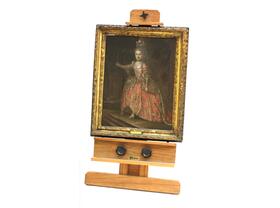18thC Venice Comes to Diss
18thC Venice Comes to Diss With Not a Gondola in Sight
By Rosei Frost
Arguably one of the most beautiful cities in the world, Venice conjures up romanticised views into of gondolas bobbing on the Grand Canal or narrow winding streets and bridges. Giovanni Antonio Canal, (Canaletto), is the most recognised painter of architectural Venice and it is likely his 18thC depictions have ensured the city’s continued popularity, (and preservation) through the ages. On a freezing cold January day nothing is better than being propelled back four hundred years and admiring these images, many which can easily be recognised today.
The architectural aspects of Venice can only tell one side of the story and a city’s true nature is formed by its people. Venice had enjoyed centuries of wealth and power by the 1700’s from an established trade route with the East and a strong naval presence in the Mediterranean. From an artistic perspective, wealth comes hand in hand with commissions. One artist favoured by the Venetian aristocracy was Pietro Longhi.
Longhi is famed for his genre paintings, these are a style of painting that depicts everyday scenes from life of both high and low class people. Historically this style of painting has been invaluable in providing visual clues of how people lived during these pre-photographic eras. History is created by interpreting written records, paintings and objects. This means that a huge cohort of people have been historically erased, those who could not write, poor people, people of colour, the list goes on. However, genre painting offers us the opportunity to peer through the window into unedited everyday scenes. Longhi offers us such jewels as ‘The Apothecary’, ‘The Rhinoceros’, ‘The Milliner’ and ‘The Fortune Teller’. All of these scenes act as photographs, capturing common place moments and the people who were there. Some depict people wearing masks and many of them show servants and people of the lower classes carrying out routine tasks. He has offered us a rare opportunity to see how the majority of us would have lived nearly four hundred years ago.
Our next Gallery Sale offers the opportunity to view the Venetian painter in the flesh. A portrait of ‘Clorinda’ (from an operatic adaptation of Tasso’s Jerusalem Delivered) defies history and gazes at us, brandishing a sword in one hand and a bejewelled sheath in the other. As a dwarf, the uniqueness of her portrait and its survival, combined with her depiction as an opera singer, lead to intrigue over her history and identity. Often people with dwarfism are depicted as servants or attendants. In this striking portrait the lady has been depicted as Clorinda, a powerful warrior. The role of Clorinda had been reprised previously in the late 17thC by a woman named Julie d’Aubigny, a person who history did not forget. She was famed for her sword skills, on and off stage, and her bi-sexuality. The engraving of Julie d’Aubigny (Mademoiselle de Maupin) could have been the influence for this Longhi portrait. Not only important for its subject matter, the costume in which she is dressed in may also be important for costume researchers. There appear to be scant examples of opera portraits from this period and her fabulous pannier dress and ermine cape can provide an insight into 18thc costume design. Guided at £6000-9000 it comes from the late Georgina Fairholme’s estate. Georgina was a celebrated interior designer and worked with clients such as Jackie Onassis bringing English sophistication into American homes.
The top lots of the sale however is in fact a painting by someone considered the most influential artist of the Modern Art movement in Africa, the Nigerian, Odinigwe Benedict Chukwukadibia Enwonwu MBE (1917-1994). He was better known as ‘Ben’ and after his studies in Government Colleges at Ibadan and Umahia under Kenneth C. Murray, he attended both the Slade and Ruskin Schools of Art in England and became the most recognised African artist with global acclaim. He also sculpted numerous works and his sitter’s included her late Majesty, Queen Elizabeth II.
The painting shown here depicts a lone female figure walking on a forest path holding aloft a basket and was a subject he often returned to. The painting is estimated at £8000-12,000 and is expected to generate much interest in a fascinating section of the Art market.
There will also be the usual selection of more local works, typical Broads scenes by Batchelder and Rackham and a lovely winter scene by the local artist Colin Burns of Pheasants and Grey Partridges. Keeping local and there are works by the very popular artist’s Geoffrey’s Chatten and Wilson, Dee Nickerson’s wonderful figural works and an Edward Wesson watercolour. Further afield and two beautiful landscapes by Frank Wootton OBE of the South Downs, better known for his aviation paintings.
So there should be something for all tastes, whether portraiture, figural, landscapes, still life studies or the natural world, we have it covered. Online catalogue at www.twgaze.co.uk with Live Bidding on www.easyliveauction.com and www.the-saleroom.com
Viewing Thursday 11th January 1-7pm, Friday 12th 9am-12noon. Morning of sale from 8.30am.

